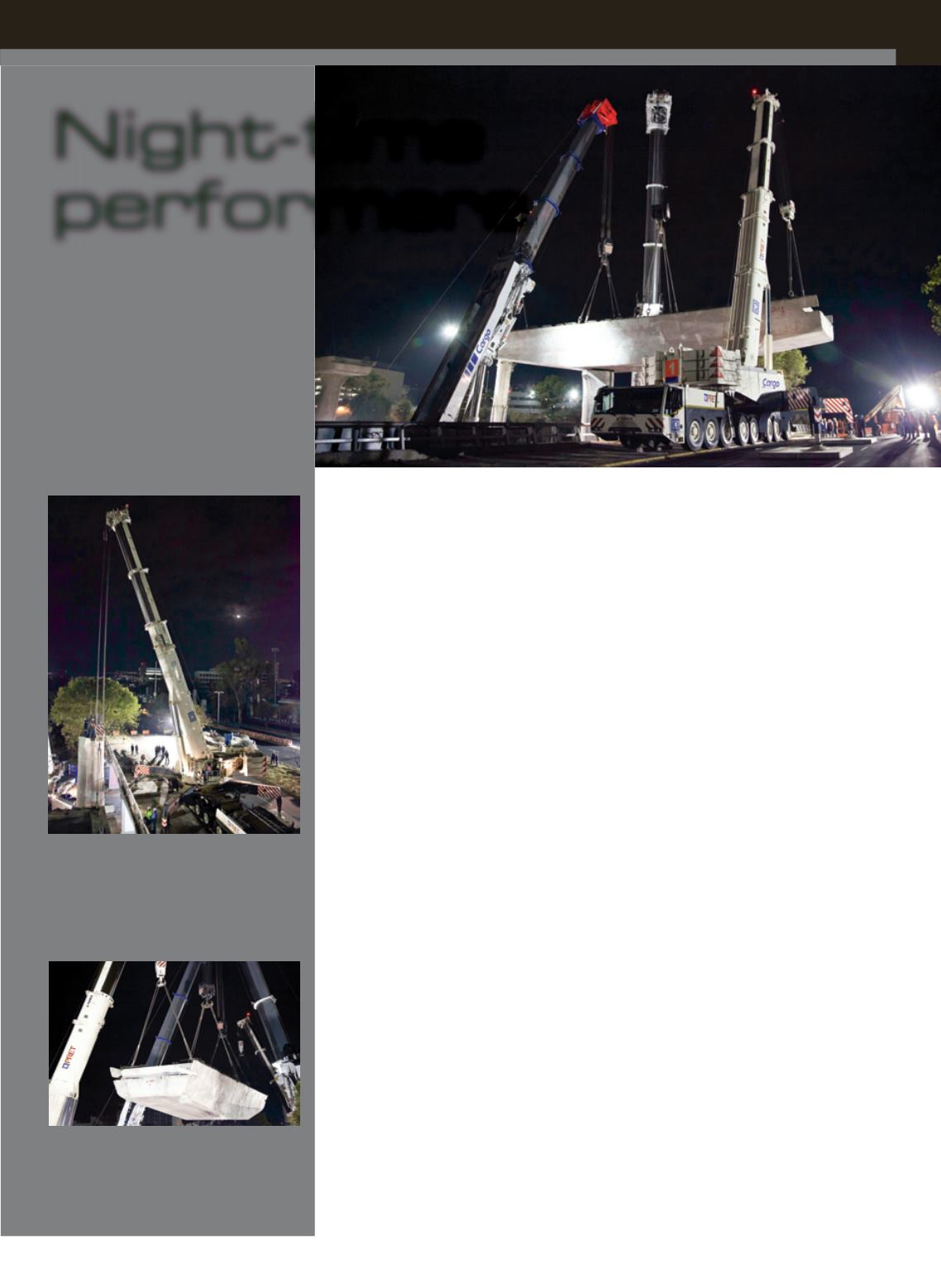
57
FEBRUARY 2014
ACT
LIFTING
SITE REPORT
Ingenieros Civiles
Asociados uses several
Terex AC 500-2 ATs
to build a highway in
Mexico City.
facility utilized 22 hectares (about
220,000 square meters of space), 15
fabrication tables and 120 molds. With an
industrialized process and a workforce of
over 2,000 workers, it was able to deliver
all pieces on time to be transported and
mounted each evening. Approximately
18,000 prefabricated elements were
utilized for the project, and they were
installed between 11 p.m. and 5 a.m., the
only time traffic was interrupted. This is
the first time this construction method has
been used in Mexico to build a complete
overhead highway. It is also the largest
urban project of its kind so far.
Urban jobsite
ICA specializes in large infrastructure,
heavy construction and civil engineering
projects. As well as employing 40,000
employees, the company also owns 12
Terex cranes including several 500-metric
ton capacity class AC 500-2 all-terrain
cranes, which are being used for erecting
the main concrete columns, beams and
components on the highway project.
Larger components are lifted using two
cranes and tandem lifts.
“Because it is an urban jobsite with
limited space for heavy lifting, and work
access was only available for six hours
each night, we needed a crane that had
quick travel speed, rapid set-up time
and excellent lift capacity,” said Ignacio
Villaseñor Sanchez, ICA equipment
director. “The TerexAC 500-2 fit the bill
perfectly.”
He said the cranes performed faultlessly
and had 97 percent availability, only
stopping for planned maintenance.
“The crane is extremely reliable and
Night-time
performers
With a 56-foot-
long carrier, the
AC 500-2 is the
most compact
eight-axle crane
in its class,
according to
Terex.
Because it is an urban jobsite with limited
space for heavy lifting, and work access
was only available for six hours each
night, ICA required cranes with quick
travel speeds, rapid set-up time and
excellent lift capacity.
W
ith a population that
exceeds 20 million,
Mexico City continues to
see rapid growth. Developing the city’s
transportation infrastructure to cope
with increasing traffic is a priority for
the capitol city federal district of Mexico.
While major investments have been made
in public transportation, Mexico City
still has one of highest concentrations of
cars in the world – more than 5.5 million
vehicles – which could likely double over
the next decade.
To relieve the potential gridlock, new
roadways must be constructed. However,
building in a massively congested city
poses huge challenges. The solution has
been to construct a major new elevated
road to the south of the city. The first
section is the 7-mile (11.3 km) long
Autopista Urbana Sur (Urban Highway
South) being built by Mexican contractor
Ingenieros Civiles Asociados SA at a cost
of about $450 million. The highway has
been designed to alleviate congestion
to the south side of the city and cut
journey times by half. This new road
features four lanes, two in each direction,
and also includes some stretches of six-
lane highway. The road connects San
Geronimo to Tlalpan Viaduct at the
second deck level of the city’s existing
elevated peripheral highway.
Given the tight space considerations
and tricky logistics in Mexico City, the
roadway is being built using prefabricated
concrete sections made offsite, about 25
miles from the construction site. Critical
to the success of the project has been the
use of several Terex all-terrain cranes.
The prefabricated concrete production
Some column sections weighed up to 425
metric tons and measured 118 to 157 feet
long and 13 to 21 feet-wide, depending on
the number of lanes they carry. Horizontal
sections weighed up to 350 metric tons.
>58


